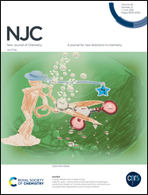Prediction of band gap for 2D hybrid organic–inorganic perovskites by using machine learning through molecular graphics descriptors†
Abstract
Two-dimensional (2D) hybrid organic–inorganic perovskites (HOIPs) have attracted considerable attention for their promising applications in solar cells and optoelectronics. However, the fast and accurate prediction of the basic band structure of 2D HOIPs is still challenging because the traditional trial-and-error experimental methods or first-principles calculations are usually inefficient. Herein, we introduce machine learning (ML)-aided models with simple descriptors based on molecular graphics and adjacency matrices for the first time to determine the band gap for 2D A2BX4 HOIPs, which avoids time-consuming ab initio calculations. The multiple stepwise regression algorithm is employed to select 6 important descriptors to represent the electronic and structural features of the molecules. Sixteen competing algorithms including artificial neural network (ANN), regression tree (RT), support vector machine (SVM), Gaussian process regression (GPR) and ensemble of regression tree (ERT) multiple models are used to derive ML models to determine the band gap of 136 2D HOIPs, and the ANN model shows the best accuracy. Based on the developed ANN model, five 2D A2BX4 HOIPs with band gaps close to the theoretical Shockley–Queisser limit (1.34 eV) are screened, which are probably excellent candidates for optoelectronics. This work reveals that ML in combination with simple descriptors can serve as an excellent strategy for the fast prediction of the key properties of HOIPs with a high accuracy.



 Please wait while we load your content...
Please wait while we load your content...